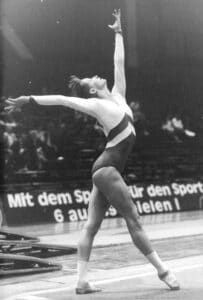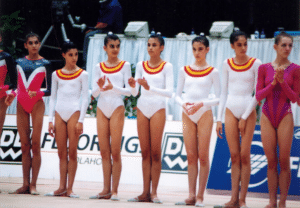Gymnastics is a sport that has been around for centuries. With its roots tracing back to ancient Greece, gymnastics has come a long way since its inception. One aspect of the sport that has evolved over the years is the leotard. In this article, we’ll answer why gymnasts wear leotards and explore the history of gymnastics leotards, from their origins to their current use in the sport.

When Were Leotards Invented?
The origins of the leotard can be traced back to the late 19th century. At that time, dance was becoming increasingly popular, and dancers were looking for clothing that would allow them to move freely and showcase their movements. This led to the development of the first dance leotards, which were one-piece garments that covered the entire body.
The gymnastics leotard was derived from the dance leotard, with modifications made to better suit the needs of gymnasts. For example, gymnastics leotards are typically made of materials that are more durable and stretchy than those used for dance leotards.
Who Invented Leotards?
The gymnastics leotard was invented by a French acrobat named Jules Léotard in the mid-1800s. Léotard was known for his daring aerial stunts, which he performed while wearing a one-piece garment that covered his entire body. This garment, which was made of stretchy material, allowed Léotard to move freely and perform his acrobatics with ease.
Other acrobats and gymnasts quickly adopted Léotard’s garment, and it eventually became known simply as the “leotard.”
When Did Gymnasts Start Wearing Leotards?
Gymnastics, as a sport, has been around for centuries. However, the use of leotards in gymnastics didn’t become prevalent until the early 20th century. Prior to this, gymnasts wore clothing that was similar to what was worn for other physical activities, such as shorts and t-shirts.
The decision to switch to leotards was made for a number of reasons. For one, leotards allow for a greater range of motion and flexibility, which is crucial in gymnastics. Additionally, they were more form-fitting, which made it easier for judges to see and evaluate the gymnast’s movements and techniques.
Why do Gymnasts Wear Leotards?
Gymnasts and acrobats started the leotard trend in the late 19th and early 20th centuries. As mentioned earlier, Jules Léotard was the first person to wear a leotard while performing acrobatics. However, it was not until the 1920s and 1930s that leotards became more widely used in gymnastics.
One of the reasons for the rise in popularity of leotards was the fact that they were more practical than the clothing that had been worn previously. Additionally, as gymnastics became more competitive, judges began to look for clothing that would allow them to better evaluate the gymnasts’ technique and movements.
he course of the 20th century, the leotard grew in popularity for many reasons.
Freedom of Movement
One of the main reasons gymnasts wear leotards is that they allow for maximum freedom of movement. Gymnastics requires a lot of flexibility and agility, and loose or baggy clothing can hinder the athlete’s performance. Leotards are tight-fitting and stretchy, which means they move with the athlete’s body and don’t get in the way.
Body Alignment
Because leotards are skin tight it’s possible to see all major lines in the body and whether elbows or knees are bent at times when they shouldn’t be. At a meet, this is essential for judges as they will score based on technique and alignment.
For coaches too it is important to be able to identify areas for improvement and leotards allow coaches to analyze their gymnast’s performance correctly.
Safety
Another reason gymnasts wear leotards is for safety. Loose clothing or jewelry can get caught on equipment, which can be dangerous for the athlete. Leotards are designed to be streamlined and minimalistic, which reduces the risk of injury.
Aesthetic
Leotards are also an important part of the aesthetic of gymnastics. They come in a variety of colors and designs and can be customized to reflect the athlete’s personality or team affiliation. The bright and eye-catching leotards add to the excitement and visual appeal of the sport.
Tradition
Finally, leotards have become a tradition in gymnastics. They have been worn by gymnasts for over a century and have become a symbol of the sport’s history and culture. Wearing a leotard is a way for gymnasts to connect with the past and to honor the athletes who came before.
Leotards Through the Decades
Gymnastics was included in the first modern Olympics of 1896 however only men were allowed to compete at the Olympics until 1932.
1896 Carl Schuhmann
The image of Carl Schuhmann at the 1896 Olympics below shows him vaulting the old-style horse wearing nothing more than a tight, long-sleeved shirt and pants.

1956 Helga Speck
This image of German gymnast Helga Speck, shows her wearing a tight-fitting top and shorts but it’s different from the one-piece leotards that would become commonplace in the 1960s. This also predates Spandex becoming the material of choice on gymnastics leotards.

1972 Olga Korbut
One of the most recognizable faces of gymnastics, Olga Korbut, is pictured in a Soviet leotard at the 1972 Munich Olympics. By now, the material had evolved into a mix of Spandex and Nylon however, the designs were still very basic.
At international events like the Olympics, designs tended to be plain and included a national emblem or flag on a basic level.
Leg cut at this time was lower, presumably to ‘protect’ ladies’ modesty.

1984 Birgit Senff
Throughout the 1970s and 80s, the most noticeable development is the high-cut leg as demonstrated by Birgit Senff in the GDR Championships of 1984.
Leotards become progressively more tight fitting and paralleled developments in difficulty levels of the skills being performed and advancements in the apparatus being used.
All of these developments brought gymnastics into the professional era with countries beginning to match the dominance of the Soviet Union and other Eastern European countries.

1995 Spanish Rhythmic Team
By the 1990s color was much more prominent in the designs of gymnastics leotards although this example from the 1995 Spanish Rhythmic team is not the boldest example. It is a cool incorporation of Spain’s national colors into the design though.
As the 20th century drew to a close, sparkles, rhinestones and other glamorous elements were added to leotard designs.

2016 Simone Biles
The history of gymnastics leotards changed significantly with increased exposure of regular gymnastics on TV, the internet and eventually social media. The changes in the way society communicates have led to the growth of a multi-million dollar gymnastics leotard industry.
The iconic Simone Biles is a globally recognized face and young gymnasts around the world are desperate to emulate not just her skills but her appearance as well.
Big leotard brands such as GK, Destira and Quatro compete for deals with National Federations to produce patriotic leotards at big events and the best-known gymnasts have their own range of designs with the same brands.
Who would have imagined such a big industry even 30 or forty years ago?

When Did Leotards Go Out of Style?
Leotards have never really gone out of style in the world of gymnastics. However, the style of leotards has evolved over the years. In the 1960s and 1970s, leotards with long sleeves and turtlenecks were popular. In the 1980s and 1990s, leotards with more elaborate designs and patterns became fashionable.
Today, gymnastics leotards are more streamlined and typically feature bright colors and unique designs. Additionally, many gymnasts wear specialized leotards for competitions that are adorned with rhinestones, sequins, and other embellishments to make them stand out.
What Were Leotards Made of Before Spandex?
Spandex, also known as elastane, was invented in 1959 by chemist Joseph Shivers at DuPont’s Benger Laboratory in Waynesboro, Virginia, USA. Synthetic fiber was first introduced to the market under the brand name Lycra in 1962.
Before the invention of spandex, leotards were typically made of a combination of cotton, nylon, and other stretchy fabrics. These fabrics provided some degree of flexibility, but they were not as stretchy as spandex, which allowed for a greater range of motion.
In the early days of gymnastics, leotards were also made of wool, which provided some warmth in colder climates but was not as comfortable or flexible as modern fabrics.
One of the earliest known uses of spandex in dancewear was by the brand Capezio, which introduced a line of spandex leotards in the early 1960s. The popularity of spandex leotards quickly grew, and they became a staple garment in dance and gymnastics.
Difference Between Gymnastics and Dance Leotards
While gymnastics and dance leotards are both one-piece garments designed to allow for ease of movement, there are some differences between the two.
Dance leotards are typically made of lighter-weight fabrics and often have more intricate designs and patterns. They may also have long sleeves, which are not as popular in gymnastics leotards. Additionally, dance leotards may be made with a wider range of materials, including lace, silk, and other delicate fabrics.
Gymnastics leotards, on the other hand, are designed to be more durable and are typically made of fabrics that can withstand the wear and tear of rigorous training and competition. They are often brightly colored and may feature bold designs, but they are not typically as ornate as dance leotards.
Conclusion
The history of gymnastics leotards is a fascinating one that spans decades. From their origins in the dance world to their evolution into the practical and fashionable garments worn by gymnasts today, leotards have played an important role in the development of the sport.
While the design of leotards has changed over the years, one thing that has remained constant is their ability to allow gymnasts to move freely and perform at their best. Whether adorned with sequins and rhinestones or designed for practicality and durability, leotards will likely continue to be a staple of gymnastics for years to come.
- How To Get Over a Mental Block In Gymnastics: A Complete Guide
 Gymnastics is a sport that requires not only physical strength and skill but also mental strength. When a gymnast feels like they cannot attempt a… Read more: How To Get Over a Mental Block In Gymnastics: A Complete Guide
Gymnastics is a sport that requires not only physical strength and skill but also mental strength. When a gymnast feels like they cannot attempt a… Read more: How To Get Over a Mental Block In Gymnastics: A Complete Guide - Find The Best Leotard For Girls (Guide)
 Finding an ideal leotard for girls isn’t just about picking a dazzling design that sparkles (although it does help!). The leotard has to fit perfectly,… Read more: Find The Best Leotard For Girls (Guide)
Finding an ideal leotard for girls isn’t just about picking a dazzling design that sparkles (although it does help!). The leotard has to fit perfectly,… Read more: Find The Best Leotard For Girls (Guide) - The Best Gymnastics Shorts (Our Top Picks)
 The best gymnastics shorts are designed to be worn over the top of a leotard providing additional coverage around the upper legs, whilst allowing gymnasts… Read more: The Best Gymnastics Shorts (Our Top Picks)
The best gymnastics shorts are designed to be worn over the top of a leotard providing additional coverage around the upper legs, whilst allowing gymnasts… Read more: The Best Gymnastics Shorts (Our Top Picks) - Decathlon Leotards – Are They Any Good?
 If you’re in the market for a new leotard, you may be wondering if Decathlon leotards are any good considering the low cost of their… Read more: Decathlon Leotards – Are They Any Good?
If you’re in the market for a new leotard, you may be wondering if Decathlon leotards are any good considering the low cost of their… Read more: Decathlon Leotards – Are They Any Good? - A Complete Guide to Gymnastics Hand Rips
 Are you tired of dealing with painful gymnastics rips on your hands from training? Look no further – this article offers a comprehensive approach to… Read more: A Complete Guide to Gymnastics Hand Rips
Are you tired of dealing with painful gymnastics rips on your hands from training? Look no further – this article offers a comprehensive approach to… Read more: A Complete Guide to Gymnastics Hand Rips - Is Gymnastics Dangerous? (Facts and Comparisons)
 Gymnastics is acknowledged as a highly technical and physically demanding sport. It inherently carries a risk of injury, which is why most coaches and clubs… Read more: Is Gymnastics Dangerous? (Facts and Comparisons)
Gymnastics is acknowledged as a highly technical and physically demanding sport. It inherently carries a risk of injury, which is why most coaches and clubs… Read more: Is Gymnastics Dangerous? (Facts and Comparisons)
